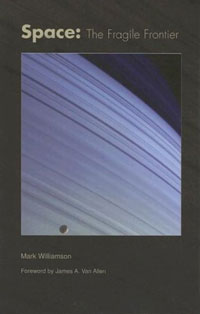Review: Space: The Fragile Frontierby Jeff Foust
|
| Williamson discusses the “problem” of satellites crashing into the surface of the Moon and other bodies. Such impacts, he claims, could disrupt scientific studies and even pose a hazard for future explorers. |
Williamson starts with one “environment of space” issue that is a real concern today: the proliferation of orbital debris surrounding the Earth. Such debris, ranging from exploded rocket stages to dropped tools to flecks of paint, have already damaged several spacecraft, and the risk for catastrophic damage to satellites or human spacecraft only grows as the number of spacecraft—and the amount of debris—continues to grow. Williamson offers a good discussion of the problem and what has been done to date to mitigate the problem, primarily through the “passivation” of upper stages of rockets to prevent their propellant tanks and batteries from exploding as well as the deorbiting of satellites (including putting GEO communications satellites into higher “graveyard” orbits) at the end of their lives.
Space: The Fragile Frontier, though, does not stop with the problem of orbital debris. Williamson goes on to consider the “problem” of satellites crashing into the surface of the Moon and other bodies. He is concerned not only with the potential of “forward contamination” of worlds like Mars that could support life with terrestrial microbes, but also on lifeless worlds like the Moon. Such impacts, he claims, could disrupt scientific studies and even pose a hazard for future explorers. On top of that, he worries about the potential of industrial activities, like strip mining and harvesting helium-3 from lunar regolith, to disfigure planetary surfaces.
After a discussion of the legal and ethical issues associated with the environment of space, Williamson presents three scenarios for the future, based on fictional accounts looking back from the centennial of Sputnik in 2057. One scenario depicts a future with unusable orbits because of space debris and a Moon littered with junk and defiled Apollo landing sites; a second describes a future with a much improved space environment, but also one with little activity beyond Earth orbit; a third tries to illustrate a happy medium between the two extremes. Such techniques are generally a little trite, and this is no exception, but it does offer a way to describe the long-term consequences of action or inaction.
The key problem with Space: The Fragile Frontier is that Williamson tends to stretch his concerns about damage to the environment of space too far. It’s one thing to be concerned about the dangers of orbital debris: it’s a well-known problem with clear examples of the hazards such debris poses. It’s much harder to get worked up about littering the lunar landscape with debris from crashed spacecraft, given that only a few dozen spacecraft and rocket stages have crashed there. Williamson writes that such impacts create “craters and metallic debris on the surface, [and] might one day present a safety hazard to lunar explorers and developers.” Given the infinitesimal fraction of the lunar surface covered by such debris, and all the other risks faced by lunar explorers, it’s hard to get concerned about this issue based on these factors alone.
| It may be that Williamson is, in fact, too early to warn of dangers beyond the known issue of orbital debris, given the relatively slow progress to date—and for at least the near future—on the exploration and development of space. |
Williamson also tends to overstate the amount of concern in the space community and the general public about this issue. Discussing the impacts of Saturn 5 third stages on the Moon as part of seismology experiments, he writes, “Undoubtedly, impacting large rocket stages on the Moon was acceptable in the 1960s, but surely it would be deemed unacceptable today.” Earlier this year, though, NASA announced that it would crash a Centaur upper stage in a crater near the lunar poles as part of a scientific investigation by the LCROSS mission, launched to the Moon along with the Lunar Reconnaissance Orbiter by that Centaur. (LCROSS itself will also crash into the Moon.) Yet there has been no noticeable outcry, from the scientific community or elsewhere, about that mission. Williamson also claims that efforts by American antinuclear activists “forced a moratorium on the use of radioisotope thermoelectric generators (RTGs) in planetary spacecraft”. However, there was no moratorium (the handful of activists who protested the use of RTGs had no effect other than generating a bit of media attention), and the New Horizons mission, carrying an RTG, launched in January of this year without incident.
At the end of Space: The Fragile Frontier Williamson draws parallels to Rachel Carson’s seminal book about the dangers of DDT, Silent Spring, which is widely credited for starting the modern environmental movement. Noting it took governments years to act upon the threats outlined in her book, he concludes that “it is never too early to warn of potential dangers” and that action should be taken now “before ‘the final frontier’ becomes a lawless, selfish, and untamed frontier.” That is an understandable concern, but it may be that Williamson is, in fact, too early to warn of dangers beyond the known issue of orbital debris, given the relatively slow progress to date—and for at least the near future—on the exploration and development of space. The biggest obstacle, though, may be human nature: individuals and societies are reluctant to take proactive action on issues that don’t appear be of immediate concern, and nothing in Space: The Fragile Frontier, for better or worse, will likely change that.
